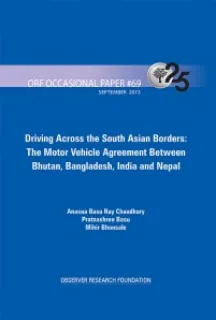In an age of increasing economic interdependencies, seamless communication has become the fulcrum of commercial and social interaction. Though the necessity of improved transport infrastructure to facilitate trade and investment between South Asian states has been acknowledged since the inception of the South Asian Association for Regional Cooperation (SAARC) in 1985, the reality has been rather different. The Partition of 1947 was a watershed, dividing age-old connectivity linkages between the states of the region. The complex nature of South Asian politics has always prevailed over geoeconomic considerations. As a result, this region has emerged as internally disconnected but otherwise geographically contiguous. The inability of the SAARC to progress has affected its regional programs, particularly those aimed at promoting connectivity among member states through economic integration. The Bangladesh-Bhutan-India-Nepal Motor Vehicle Agreement (BBIN MVA), signed on 15 June 2015, is thus a breakthrough.
Acknowledging the importance of physical connectivity, SAARC has been trying to enact a Motor Vehicle Agreement for the Regulation of Passenger and Cargo Vehicular Traffic (MVA) which would permit free cross-border movement of goods and transport among members. The proposal to finalise the SAARC MVA was submitted in the 18th SAARC Summit held in Kathmandu, Nepal on 26-27 November 2014. Earlier, a meeting of SAARC transport ministers in Colombo, Sri Lanka in 2009, had approved the recommendations of the Intergovernmental Group on Transport (IGGT) to set up an expert group to negotiate and finalise the text of the draft Regional Agreement on Motor Vehicles for SAARC Member States. Later, the expert group finalised the draft agreement which was subsequently endorsed by the fifth meeting of the SAARC IGGT in 2014, attended by all member states except Maldives.
The initiative had been designed to offer opportunities for enhanced economic and social engagement, and in the process minimise geopolitical constraints to such relations. The framework agreement, however, was not signed at the 18th SAARC Summit because of opposition from Pakistan. As a result, the initiative failed to garner the support of all member countries and negotiations continued for a long time, held hostage to political factors that appeared to gain priority over constructive, forward-looking engagements.
In contemporary South Asian scenario, India-Pakistan relations still remain a major irritant. India-Pakistan tensions on cross-border shelling and the cancellation of the foreign secretary talks reflect ongoing hostility. It thus becomes relevant to encourage understanding among the eastern neighbours of South Asia and promote sub-regional cooperation. This rationale seems to have been realised by Bangladesh, Bhutan, India and Nepal. Indian Prime Minister Narendra Modi, for one, declared in his speech at the 18th SAARC summit in Kathmandu, “South Asia is slowly coming together. India and Bangladesh have deepened their links through rail, road, power and transit. India and Nepal have started a new era of cooperation in energy and, India and Bhutan are making those ties stronger by the day”.
The BBIN MVA signed by these four eastern states of South Asia is a positive step towards creating a strong sub-region. It is expected that the BBIN MVA will permit seamless connectivity of passengers and vehicles through the roadways of these countries. The agreement was signed in Thimpu, Bhutan, by Minister for Physical Infrastructure and Transport of Nepal Bimalendra Nidhi, Bangladesh's Minister of Road Transport and Bridges Obaidul Quader, Bhutanese Minister for Information and Communications D.N. Dhungyel and Nitin Jairam Gadkari, Indian Minister for Road Transport and Highways, and Shipping.

 PDF Download
PDF Download



 PREV
PREV



.png)
.png)